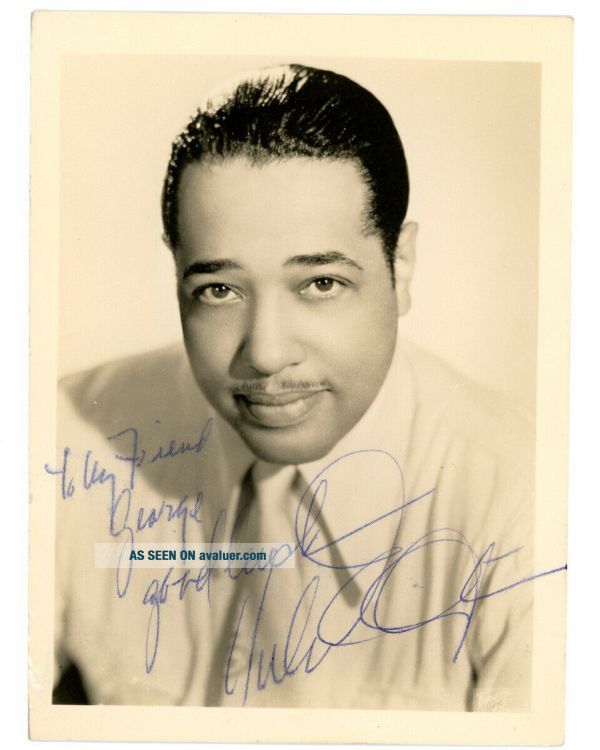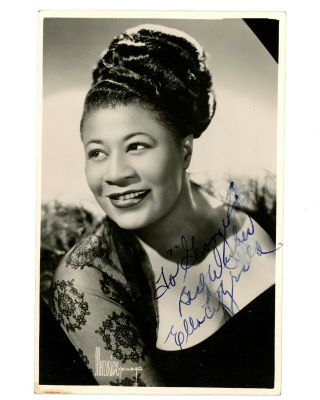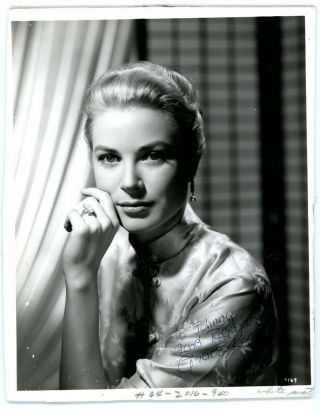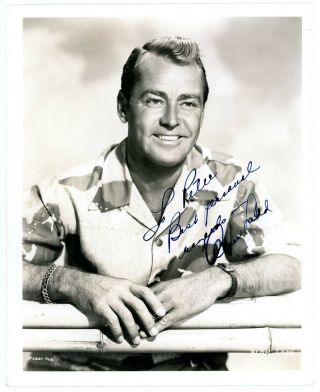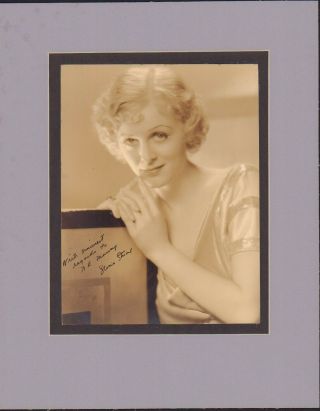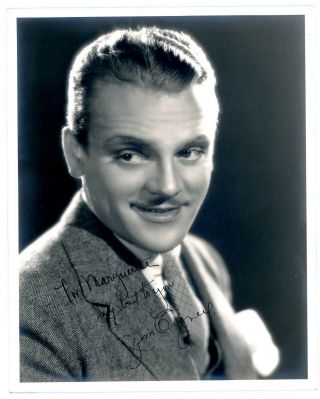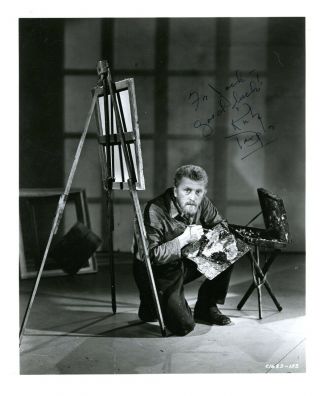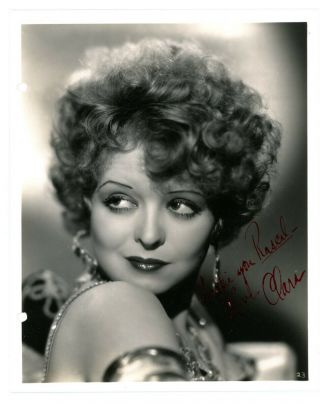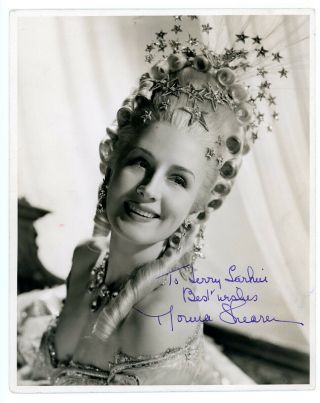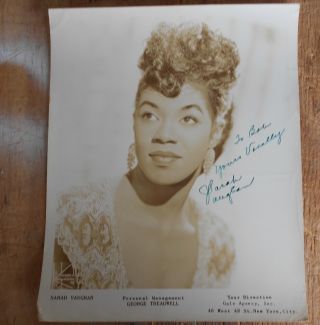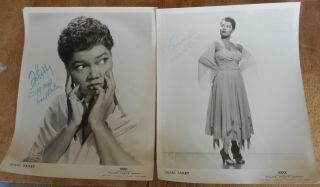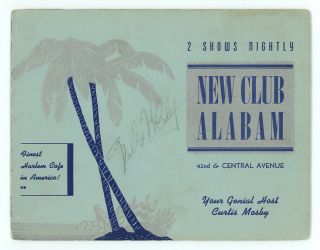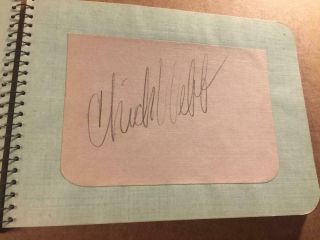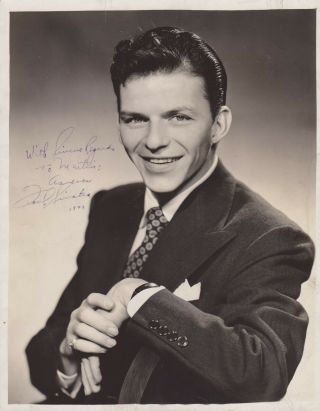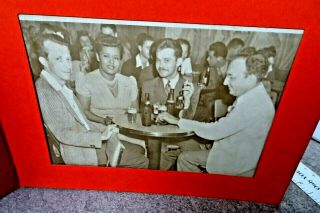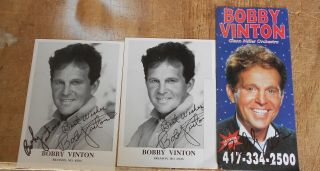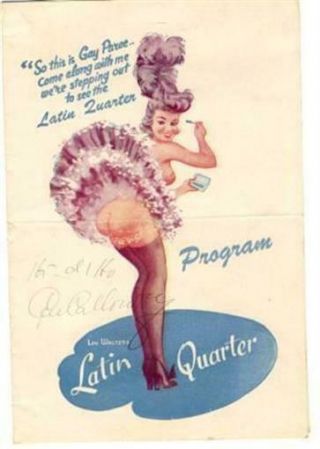DUKE ELLINGTON VINTAGE 1950s SIGNED DBLWT PHOTOGRAPH AUTOGRAPHED UACC
Item History & Price
HIGHLY RECOMMENDED - GREAT EXAMPLE: Jazz legend DUKE ELLINGTON authent...ic original hand signed vintage 1950s gelatin silver heavyweight photograph. Autograph is written with a blue ink ballpoint pen.
- This autographed item has beenauthenticated by MY MOVIEMEMORABILIA & MORE, a UACC (Universal Autograph Collectors Club)Registered Dealer (No. RD320), which must abide by the UACC Code of Ethics, allpolicies that the UACC has enacted and must have a good standing as a reputabledealer recommended by long-term UACC dealers. We have years of selling tobuyers internationally with a 100% positive feedback. All of my autographed items have a lifetime money back guarantee ofauthenticity (see Return Policy).- SIZE: approx. 7" X 5"
- TONE: sepia toned B&W- FINISH: pearl glossy- OTHER: double-weight
_______________________________________________________________________________
SHIPPING TERMS
- I ship all items using, what I call, triple protection packing. The photos are inserted into a display bag with a white board, then packed in between two thick packaging boards and lastly wrapped with plastic film for weather protection before being placed into the shipping envelope.
- The shipping cost for U.S. shipments includes USPS "Delivery Confirmation" tracking.
- Combined Shipping Discounts: If you purchase more than one item within a two week period that will be shipped together just add $2.00 to the base shipping cost. This will cover any additional quantity of a similar item purchased. If you purchase different types of items (i.e. clothes and photos) please contact me for the lowest possible shipping discount. Please wait for me to issue the invoice with the reduced shipping cost before making payment.
PAYMENT TERMS
- Please pay within three (3) days of purchase.
- I reserve the right to re-list the item(s) if payment is not received within seven (7) days.
- All sales taxes applicable to the City of Los Angeles, State ofCalifornia and the 2019 Marketplace Sales Tax Law in other states shall beapplied.
CUSTOMER SERVICE
I will respond to all inquiries within 24 hours. Please feel free to contact me anytime at 1-310-880-8140 (Pacific Standard Time)
DUKE ELLINGTON BIO EdwardKennedy "Duke" Ellington (April 29, 1899 ? May 24, 1974) was anAmerican composer, pianist, and big band leader. Ellington wrote over 1, 000compositions. In the words of Bob Blumenthal of The Boston Globe"In the century since his birth, there has been no greater composer, American or otherwise, than Edward Kennedy Ellington." A prominentfigure in the history of jazz, Ellington's music stretched into various othergenres, including blues, gospel, film scores, popular, and classical. Hiscareer spanned more than 50 years and included leading his orchestra, composingan inexhaustible songbook, scoring for movies, composing stage musicals, andworld tours. Several of his instrumental works were adapted into songs thatbecame standards. Due to his inventive use of the orchestra, or big band, andthanks to his eloquence and extraordinary charisma, he is generally consideredto have elevated the perception of jazz to an art form on a par with othertraditional genres of music. His reputation increased after his death and thePulitzer Prize Board bestowed on him a special posthumous honor in 1999. Ellingtoncalled his music "American Music" rather than jazz, and liked todescribe those who impressed him as "beyond category." These includedmany of the musicians who were members of his orchestra, some of whom areconsidered among the best in jazz in their own right, but it was Ellington whomelded them into one of the most well-known jazz orchestral units in thehistory of jazz. He often composed specifically for the style and skills ofthese individuals, such as "Jeep's Blues" for Johnny Hodges, "Concerto for Cootie" for Cootie Williams, which later became"Do Nothing Till You Hear from Me" with Bob Russell's lyrics, and"The Mooche" for Tricky Sam Nanton and Bubber Miley. He also recordedsongs written by his bandsmen, such as Juan Tizol's "Caravan" and"Perdido" which brought the 'Spanish Tinge' to big-band jazz. Severalmembers of the orchestra remained there for several decades. After 1941, hefrequently collaborated with composer-arranger-pianist Billy Strayhorn, whom hecalled his "writing and arranging companion." Ellington recorded formany American record companies, and appeared in several films.Ellingtonled his band from 1923 until his death in 1974. His son Mercer Ellington, whohad already been handling all administrative aspects of his father's businessfor several decades, led the band until his own death in 1996. At that point, the original band dissolved. Paul Ellington, Mercer's youngest son and executorof the Duke Ellington estate, kept the Duke Ellington Orchestra going fromMercer's death onwards. EdwardKennedy Ellington was born on April 29, 1899 to James Edward Ellington andDaisy Kennedy Ellington. Daisy and J.E. were both pianists. She primarilyplayed parlor songs and he operatic airs. They lived with his maternalgrandparents at 2129 Ida Place(now Ward Place), NW in the West End neighborhood of Washington, D.C. His father, James EdwardEllington was born in Lincolnton, North Carolina on April 15, 1879 and moved to Washington, D.C.in 1886 with his parents. Daisy Kennedy, was born in Washington, D.C.on January 4, 1879, and was the daughter of a former American slave. JamesEllington made blueprints for the United States Navy. He also worked as abutler for Dr. Middleton F. Cuthbert, a prominent white physician, andoccasionally worked as a White House caterer. At the ageof seven Ellington began taking piano lessons from Marietta Clinkscales. Daisysurrounded her son with dignified women to reinforce his manners and teach himto live elegantly. Ellington?s childhood friends noticed that "his casual, offhand manner, his easy grace, and his dapper dress gave him the bearing of ayoung nobleman", and began calling him Duke. Ellington credited his"chum" Edgar McEntree for the nickname. "I think he felt that inorder for me to be eligible for his constant companionship, I should have atitle. So he called me Duke." ThoughEllington took piano lessons, he was more interested in baseball."President Roosevelt (Teddy) would come by on his horse sometimes, andstop and watch us play, " he recalled. Ellington went to Armstrong TechnicalHigh School in Washington, D.C.He got his first job selling peanuts at Washington Senators baseball games.In thesummer of 1914, while working as a soda jerk at the Poodle Dog Cafe, he wrotehis first composition, "Soda Fountain Rag" (also known as the"Poodle Dog Rag"). Ellington created "Soda Fountain Rag" byear, because he had not yet learned to read and write music. "I would playthe 'Soda Fountain Rag' as a one-step, two-step, waltz, tango, and foxtrot, " Ellington recalled. "Listeners never knew it was the samepiece. I was established as having my own repertoire." In his autobiography, Music is my Mistress (1973), Ellington said he missed more lessons thanhe attended, feeling at the time that playing the piano was not his talent.Ellington started sneaking into Frank Holiday's Poolroom at the age offourteen. Hearing the poolroom pianists play ignited Ellington's love for theinstrument and he began to take his piano studies seriously. Among the manypiano players he listened to, he listened to Doc Perry, Lester Dishman, LouisBrown, Turner Layton, Gertie Wells, Clarence Bowser, Sticky Mack, Blind Johnny, Cliff Jackson, Claude Hopkins, Phil Wurd, Caroline Thornton, Luckey Roberts, Eubie Blake, Joe Rochester, and Harvey Brooks. Ellingtonbegan listening to, watching, and imitating ragtime pianists, not only in Washington, D.C., but in Philadelphia and Atlantic City, where he vacationed with his mother during thesummer months. Dunbar High School music teacherHenry Lee Grant gave him private lessons in harmony. With the additionalguidance of Washingtonpianist and band leader Oliver "Doc" Perry, Ellington learned to readsheet music, project a professional style, and improve his technique. Ellingtonwas also inspired by his first encounters with stride pianists James P. Johnsonand Luckey Roberts. Later in New Yorkhe took advice from Will Marion Cook, Fats Waller, and Sidney Bechet. Ellingtonstarted to play gigs in cafés and clubs in and around Washington, D.C. and his attachment grew to be so strongthat he turned down an art scholarship to the Pratt Institute in Brooklyn in 1916. Three months before graduating hedropped out of Armstrong Manual Training School, where he was studying commercial art. From 1917through 1919, Ellington launched his musical career, painting commercial signsby day and playing piano by night. Through his day job, Duke's entrepreneurialside came out: when a customer would ask him to make a sign for a dance orparty, he would ask them if they had musical entertainment; if not, Ellingtonwould ask if he could play for them. He also had a messenger job with the U.S.Navy and State Departments. Ellington moved out of his parents' home and boughthis own as he became a successful pianist. At first, he played in otherensembles, and in late 1917 formed his first group, "The Duke?sSerenaders" ("Colored Syncopators", his telephone directoryadvertising proclaimed). He was not only a member, but also the booking agent.His first play date was at the True Reformer's Hall, where he took home 75cents. Ellingtonplayed throughout the Washington, D.C. area and into Virginiafor private society balls and embassy parties. The band included Otto Hardwick, who switched from bass to saxophone; Arthur Whetsol on trumpet; Elmer Snowdenon banjo; and Sonny Greer on drums. The band thrived, performing for bothAfrican-American and white audiences, a rarity during the racially dividedtimes. When hisdrummer Sonny Greer was invited to join the Wilber Sweatman Orchestra in New York City, Ellington made the fateful decision toleave behind his successful career in Washington, D.C., and move to Harlem, becoming one of the figures of the Harlem Renaissance. New dance crazes likethe Charleston emerged in Harlem, as well as African-American musical theater, including Eubie Blake's ShuffleAlong. After the young musicians left the Sweatman Orchestra to strike outon their own, they found an emerging jazz scene that was highly competitive andhard to crack. They hustled pool by day and played whatever gigs they couldfind. The young band met Willie "The Lion" Smith who introduced themto the scene and gave them some money. They played at rent-house parties forincome. After a few months the young musicians returned to Washington, D.C., feeling discouraged.In June 1923a gig in Atlantic City, New Jersey, led to a play date at the prestigious Exclusive Club in Harlem. This was followed in September 1923 by a move tothe Hollywood Club ? 49th and Broadway ? and a four-year engagement, which gaveEllington a solid artistic base. He was known to play the bugle at the end ofeach performance. The group was called Elmer Snowden and his Black SoxOrchestra and had seven members, including James "Bubber" Miley. Theyrenamed themselves "The Washingtonians". Snowden left the group inearly 1924 and Ellington took over as bandleader. After a fire the club wasre-opened as the Club Kentucky (often referred to as the "KentuckyClub"), an engagement which set the stage for the biggest opportunities inEllington's life.Ellingtonmade eight records in 1924, receiving composing credit on three including ChooChoo.[20] In 1925 Ellington contributed four songs to ChocolateKiddies, an all-African-American revue which introduced European audiencesto African-American styles and performers. "Duke Ellington and hisKentucky Club Orchestra" grew to a ten-piece organization; they developedtheir distinct sound by displaying the non-traditional expression ofEllington?s arrangements, the street rhythms of Harlem, and the exotic-soundingtrombone growls and wah-wahs, high-squealing trumpets, and sultry saxophoneblues licks of the band members. For a short time soprano saxophonist SidneyBechet played with the group, imparting his propulsive swing and superiormusicianship to the young band members. This helped attract the attention ofsome of the biggest names of jazz, including Paul Whiteman.In 1927 KingOliver turned down a regular booking for his group as the house band at Harlem's Cotton Club; the offer passed to Ellington. Witha weekly radio broadcast and famous white clientele nightly pouring in to seethem, Ellington and his band thrived in the period from 1932 to 1942, a goldenage for the band.Ellingtonwas joined in New York Cityby his wife, Edna Thompson, and son Mercer in the late twenties, but the couplesoon permanently separated. According to her obituary in Jet magazine, she was "[h]omesick for Washington"and returned (she died in 1967). Althoughtrumpeter Bubber Miley was a member of the orchestra for only a short period, he had a major influence on Ellington's sound. An early exponent of growl trumpet, his style changed the "sweet" dance band sound of the group to onethat was hotter, which contemporaries termed 'jungle' style. He also composedmost of "Black and Tan Fantasy" and "Creole Love Call". Analcoholic, Miley had to leave the band before they gained wider fame. He diedin 1932 at the age of twenty-nine. He was an important influence on CootieWilliams, who replaced him.In 1927Ellington made a career-advancing agreement with agent-publisher Irving Mills, giving Mills a 45% interest in Ellington's future.[24] Mills had aneye for new talent and early on published compositions by Hoagy Carmichael, Dorothy Fields, and Harold Arlen. During the 1930s Ellington's popularitycontinued to increase ? largely as a result of the promotional skills of Mills? who got more than his fair share of co-composer credits. Mills arrangedrecording sessions on the Brunswick, Victor, andColumbia labelswhich gave Ellington popular recognition. Mills lifted the management burdenfrom Ellington's shoulders, allowing him to focus on his band's sound and hiscompositions. Ellington ended his association with Mills in 1937, although hecontinued to record under Mills' banner through to 1940.At theCotton Club, Ellington's group performed all the music for the revues, whichmixed comedy, dance numbers, vaudeville, burlesque, music, and illegal alcohol.The musical numbers were composed by Jimmy McHugh and the lyrics by DorothyFields (later Harold Arlen and Ted Koehler), with some Ellington originalsmixed in. Weekly radio broadcasts from the club gave Ellington nationalexposure. In 1929 Ellington appeared in his first movie, a nineteen-minuteall-African-American RKO short, Black and Tan, in which he played thehero "Duke". In the same year, The Cotton Club Orchestra appeared onstage for several months in Florenz Ziegfeld's Show Girl, along withvaudeville stars Jimmy Durante, Eddie Foy, Jr., Al Jolson, Ruby Keeler, andwith music and lyrics by George Gershwin and Gus Kahn. That feverish periodalso included numerous recordings, under the pseudonyms "WhoopeeMakers", "The Jungle Band", "Harlem Footwarmers", andthe "Ten Black Berries". In 1930 Ellington and his Orchestraconnected with a whole different audience in a concert with Maurice Chevalierand they also performed at the Roseland Ballroom, "America'sforemost ballroom". Noted composer Percy Grainger was also an earlyadmirer and supporter.In 1929, when Ellington conducted the orchestra for Show Girl, he met WillVodery, Ziegfeld?s musical supervisor. In his 1946 biography, Duke Ellington, Barry Ulanov wrote:From Vodery, as he(Ellington) says himself, he drew his chromatic convictions, his uses of thetones ordinarily extraneous to the diatonic scale, with the consequentalteration of the harmonic character of his music, its broadening, Thedeepening of his resources. It has become customary to ascribe the classicalinfluences upon Duke - Delius, Debussy and Ravel - to direct contact with theirmusic. Actually his serious appreciation of those and other modern composers, came after his meeting with Vodery. As theDepression worsened, the recording industry was in crisis, dropping over 90% ofits artists by 1933. Ellington and his orchestra survived the hard times bytaking to the road in a series of tours. Radio exposure also helped maintainpopularity. Ivie Anderson was hired as their featured vocalist. Sonny Greer hadbeen providing occasional vocals and continued to do in a cross-talk featurewith Anderson.Ellington, however, later had many different vocalists, including Herb Jeffries(until 1943) and Al Hibbler (who replaced Jeffries in 1943 and continued until1951).Ellingtonled the orchestra by conducting from the keyboard using piano cues and visualgestures; very rarely did he conduct using a baton. As a bandleader Ellingtonwas not a strict disciplinarian; he maintained control of his orchestra with acrafty combination of charm, humor, flattery, and astute psychology. A complex, private person, he revealed his feelings to only his closest intimates and effectivelyused his public persona to deflect attention away from himself.While theband's United States audience remained mainly African-American in this period, the Cotton Club had a near-exclusive white clientele and the Ellingtonorchestra had a huge following overseas, exemplified by the success of theirtrip to England in 1933 and their 1934 visit to the European mainland. TheEnglish visit saw Ellington win praise from members of the 'serious' musiccommunity, including composer Constant Lambert, which gave a boost toEllington's aspiration to compose longer works. For agent Mills it was apublicity triumph, as Ellington was now internationally known. On the band'stour through the segregated South in 1934, they avoided some of the travelingdifficulties of African-Americans by touring in private railcars. Theseprovided easy accommodations, dining, and storage for equipment while avoidingthe indignities of segregated facilities.The death ofEllington's mother in 1935 led to a temporary hiatus in his career. Competitionwas also intensifying, as African-American and white swing bands began toreceive popular attention, including those of Benny Goodman, Tommy Dorsey, Jimmy Dorsey, Jimmie Lunceford, Benny Carter, Earl Hines, Chick Webb, and CountBasie. Swing dancing became a youth phenomenon, particularly with white collegeaudiences, and "danceability" drove record sales and bookings.Jukeboxes proliferated nationwide, spreading the gospel of "swing".Ellington band could certainly swing, but Ellington's strengths were mood andnuance, and richness of composition; hence his statement "jazz is music;swing is business". Ellington countered with two developments. He maderecordings of smaller groups (sextets, octets, and nonets) drawn from histhen-15-man orchestra and he composed pieces intended to feature specificinstrumentalist, as with "Jeep's Blues" for Johnny Hodges, "Yearning for Love" for Lawrence Brown, "Trumpet in Spades"for Rex Stewart, "Echoes of Harlem" for Cootie Williams and"Clarinet Lament" for Barney Bigard.In 1937Ellington returned to the Cotton Club which had relocated to the mid-towntheater district. In the summer of that year, his father died, and due to manyexpenses, Ellington's finances were tight. Things improved in 1938 and he metand moved in with Cotton Club employee Beatrice "Evie" Ellis. Aftersplitting with agent Irving Mills, he signed on with the William Morris Agency. The 1930s endedwith a very successful European tour just as World War II loomed.Ellingtondelivered some huge hits during the 1930s, which greatly helped to build hisoverall reputation. Some of them include: "Mood Indigo" (1930), "It Don't Mean a Thing (If It Ain't Got That Swing)" (1932), "Sophisticated Lady" (1933), "Solitude" (1934), "In aSentimental Mood" (1935), "Caravan" (1937), "I Let A SongGo Out Of My Heart" (1938). "Take the "A" Train" whichhit big in 1941, was written by Billy Strayhorn.Strayhorn, originally hired as a lyricist, began his association with Ellington in 1939.Nicknamed "Swee' Pea" for his mild manner, Strayhorn soon became avital member of the Ellington Organization. Ellington showed great fondnesskept the Duke Ellington Orchestra going for Strayhorn and never failed to speakglowingly of the man and their collaborative working relationship, "myright arm, my left arm, all the eyes in the back of my head, my brain waves inhis head, and his in mine". Strayhorn, with his training in classicalmusic, not only contributed his original lyrics and music, but also arrangedand polished many of Ellington's works, becoming a second Ellington or"Duke's doppelganger". It was not uncommon for Strayhorn to fill infor Duke, whether in conducting or rehearsing the band, playing the piano, onstage, and in the recording studio. The bandreached a creative peak in the early 1940s, when Ellington and a smallhand-picked group of his composers and arrangers wrote for an orchestra ofdistinctive voices who displayed tremendous creativity. Some of themusicians created a sensation in their own right. The short-lived Jimmy Blantontransformed the use of double bass in jazz, allowing it to function as a solorather than a rhythm instrument alone. Ben Webster, the Orchestra's firstregular tenor saxophonist, started a rivalry with Johnny Hodges as theOrchestra's foremost voice in the sax section. Ray Nance joined, replacingCootie Williams (who had "defected", contemporary wags claimed, toBenny Goodman). Nance, however, added violin to the instrumental colorsEllington had at his disposal.Three-minutemasterpieces flowed from the minds of Ellington, Billy Strayhorn, Ellington'sson Mercer Ellington, Mary Lou Williams and members of the Orchestra."Cotton Tail", "Main Stem", "Harlem Airshaft", "Sidewalks of New York (East Side, West Side)", "Jack the bear", and dozens of others date from this period.Privatelymade recordings of Nance's first concert date, at Fargo, North Dakota, on November 7, 1940 by Jack Towersand Dick Burris, are probably the most effective display of the band duringthis period. These recordings, later released as Duke Ellington at Fargo, 1940 Live, areamong the first of innumerable live performances which survive, made byenthusiasts or broadcasters, significantly expanding the Ellington discography.Ellington'slong-term aim became to extend the jazz form from the three-minute limit of the78 rpm record side, of which he was an acknowledged master. He had composed andrecorded Creole Rhapsody as early as 1931 (issued as both sides of12" record for Victor and both sides of a 10" record for Brunswick), and his tribute to his mother, "Reminiscing in Tempo, " had filledfour 10" record sides in 1935; however, it was not until the 1940s thatthis became a regular feature of Ellington's work.In this, hewas helped by Strayhorn, who had enjoyed a more thorough training in the formsassociated with classical music than Ellington. The first of these, "Black, Brown, and Beige" (1943), was dedicated to telling the storyof African-Americans, and the place of slavery and the church in their history.Ellington debuted Black, Brown and Beige in Carnegie Hall on January 23, 1943, beginning a series of concerts there suited to displaying Ellington'slonger works. While some jazz musicians had played at Carnegie Hall before, fewhad performed anything as elaborate as Ellington?s work.Unfortunately, starting a regular pattern, Ellington's longer works were generally notwell-received. Jump for Joy, a full-length musical based on themes ofAfrican-American identity, debuted on July 10, 1941 at the Mayan Theater in Los Angeles. Although ithad the support of the Hollywoodestablishment, and received mostly positive reviews, its socio-politicaloutlook provoked a negative reaction among some members of the public. It ranfor 122 performances until September 29, 1941, with a brief revival in Novemberof that year. Its subject matter did not make it appealing to Broadway, despiteEllington's plans to take it there. Thesettlement of the first recording ban of 1942?43 had a serious effect on allthe big bands because of the increase in royalty payments to musicians whichresulted from it. The financial viability of Ellington's Orchestra came underthreat, though Ellington's income as a songwriter ultimately subsidized it.Ellington always spent lavishly and although he drew a respectable income fromthe Orchestra's operations, the band's income often just covered expenses. The musicindustry's focus shifted away from the Big Bands to the work of solo vocalistssuch as the young Frank Sinatra, Ella Fitzgerald, Billie Holliday andmainstream groups like The Andrews Sisters as World War II drew to a close.While Ellington had featured some of the most talented singers of the dayfronting his orchestra, he and his band took a back seat to no one, which sethim down a path that put him increasingly at odds with the growing recordingindustry which was profiting from celebrity singers who were cheaper to keepthan a big band, and produced bigger revenues.By the mid1940s artists were creatively changing. One of Ellington's composer-arrangers, Mary Lou Williams, left Ellington in 1943 and by 1945 was working with DizzyGillespie on a new form of jazz music, "Bebop."Beboprebelled against mainstream jazz and the strict forms of which Ellington wasperhaps its most well known standard-bearer. The music, which had redefined theAmerican sound over 35 years, was about to be shaken up.It wouldtake another ten years for Bebop to begin catching on with jazz aficionadosworld-wide, but it was an early hit with club owners of smaller venues whocould draw the jazz form's growing audiences in New York City at a fraction of the cost ofhosting a big band, particularly one of Ellington's caliber. Newer, smallerbands and splinter forms of music increasingly put pressure on the bigger clubswho paid out increasingly more to maintain their big bands. Ellington's eliteband was a costly enterprise that, along with his excessive personal spending, always teetered on the brink of break-even. The new music trends eventually pushedit over the edge and put Ellington out on the road in search of venues thatcould afford to showcase his music.Bebop wasalso a huge shift for young talent, from Charlie Parker to John Coltrane toThelonious Monk who did not embrace Big Band and sought out new creativefrontiers, redefining "modern" jazz music forever. Ellington did notrecruit or embrace these new artists and change with the times.In 1950another emerging musical trend, the African-American popular music style knownas Rhythm and Blues driven by a new generation of composers and musicians likeFats Domino drew away young audiences from both the African-American and whitecommunities, and ultimately unified those audiences as R&B morphed intoRock & Roll which expanded the cults of the singers from the Big Band erato the singer/songwriters from Domino to Elvis Presley to Buddy Holly. Again, Ellington did not embrace the new musical form, leaving him further in thegrowing dust cloud of musical history.Ellingtoncontinued on his own course through these tectonic shifts in the musicbusiness. He did not wholly resist trends while trying to turn out major works.The Kay Davis vocal feature "Transblucency" was an attempt to caterto the singer-centric music world. He still performed major extendedcompositions such as Harlem (1950), whose score he presented to music-loving President Harry Truman, but theseworks were rapidly becoming reflections of his greatness in the 1930s and1940s, and not ground-breaking works that rattled the music world back into theBig Band camp.In 1951, Ellington suffered a major loss of personnel, with Sonny Greer, Lawrence Brown, and most significantly Johnny Hodges, leaving to pursue other ventures. Lackingoverseas opportunities and motion picture appearances, Ellington's Orchestrasurvived on "one-nighters" and whatever else came their way.By thesummer of 1955 the band was performing for six weeks at the Aquacade in Flushing, New York, where Ellington is supposed to have"invented" a drink known as "The Tornado, " the onlyalcoholic concoction that features his signature Coca-Cola and sugar. Ellingtonhad hoped that television would provide a significant new outlet for his typeof jazz was not fulfilled. Tastes and trends had moved on without him. Theintroduction of the 33 1/3 rpm LP record and hi-fi phonograph though, did givenew life to many of his older compositions. However by 1955, after three yearsof recording for Capitol, Ellington no longer had a regular recordingaffiliation.The musicbusiness' increasing factionization into specific forms of rock-and-roll, country, bluegrass, or jazz broke down into even more sub-sets, and opened thedoor for the second act in Duke Ellington's career. An internationalfascination with Jazz re-opened the door at record labels to artists likeEllington and Louis Armstrong who had found themselves out of step with thetimes for the last half-decade. The Ellington who was too big or too proud tochange would now appear with a variety of artists from the different jazzforms.Ellington'sappearance at the Newport Jazz Festival on July 7, 1956 returned him to widerprominence and exposed him to new audiences. The feature "Diminuendo andCrescendo in Blue", with saxophonist Paul Gonsalves's six-minute saxophonesolo, had been in the band's book since 1937, but on this occasion nearlycreated a riot. The revived attention should not have surprised anyone ? Hodgeshad returned to the fold the previous year, and Ellington's collaboration withStrayhorn had been renewed around the same time, under terms more amenable tothe younger man. Such Sweet Thunder (1957), based on Shakespeare's playsand characters, and The Queen's Suite, dedicated to Queen Elizabeth II, were products of the renewed impetus which the Newport appearance helped to create.A new recordcontract with Columbiaproduced Ellington's best-selling LP Ellington at Newport and yieldedsix years of recording stability under producer Irving Townsend, who coaxedboth commercial and artistic productions from Ellington. In 1957, CBS (Columbia's parentcorporation) aired a live television production of A Drum Is a Woman, anallegorical suite which received mixed reviews. Festival appearances at the newMonterey Jazz Festival and elsewhere provided venues for live exposure, and aEuropean tour in 1958 was wildly received.After a25-year gap, Ellington (with Strayhorn) returned to work on film scores, thistime for Anatomy of a Murder (1959) and Paris Blues (1961).Ellington and Strayhorn, always looking for new musical territory, producedadaptations of John Steinbeck's novel Sweet Thursday, Tchaikovsky's NutcrackerSuite and Edvard Grieg's Peer Gynt. The late 1950s also saw EllaFitzgerald record her Duke Ellington Songbook with Ellington and hisorchestra?a recognition that Ellington's songs had now become part of thecultural canon known as the "Great American Songbook".DetroitFree Pressmusic critic Mark Stryker concludes that the work of Billy Strayhorn andEllington in Anatomy of a Murder, the trial court drama film directed byOtto Preminger in 1959, is "indispensable, [although] . . . too sketchy torank in the top echelon among Ellington-Strayhorn masterpiece suites like SuchSweet Thunder and The Far East Suite, but its most inspired momentsare their equal."[36] Film historians have recognized thesoundtrack "as a landmark ? the first significant Hollywood film music byAfrican Americans comprising non-diegetic music, that is, music whose source isnot visible or implied by action in the film, like an on-screen band." Thescore avoided the cultural stereotypes which previously characterized jazzscores and rejected a strict adherence to visuals in ways that presaged the NewWave cinema of the ?60s".In the early1960s, Ellington embraced recording with artists who had been fierce rivals ofthe past, or who had been young artists from the Bebop beginnings whom he didnot associate with. The Ellington and Count Basie orchestras recorded together.During a period when he was between recording contracts he made a records withLouis Armstrong (Roulette), Coleman Hawkins, John Coltrane (both for Impulse)and participated in a session with Charles Mingus and Max Roach which producedthe Money Jungle (United Artists) album.Ironically, the singer most responsible for setting off the changes that brought an end tothe big band era became Ellington's salvation. He signed to Frank Sinatra's newReprise label. Musicians who had previously worked with Ellington returned tothe Orchestra as members: Lawrence Brown in 1960 and Cootie Williams in 1962.Theinternational mania for jazz reinstated Ellington as one of the highest earningartists in jazz. He performed all over the world; a significant part of eachyear was now spent making overseas tours.He formednotable new working relationships with international artists from around theworld, including the Swedish vocalist Alice Babs, and South African musiciansDollar Brand and Sathima Bea Benjamin (A Morning in Paris, 1963/1997).His earlierhits became big sellers in the rediscovery of the music world-wide, earningEllington impressive royalties."Thewriting and playing of music is a matter of intent.... You can't just throw apaint brush against the wall and call whatever happens art. My music fits thetonal personality of the player. I think too strongly in terms of altering mymusic to fit the performer to be impressed by accidental music. You can't takedoodling seriously." Ellingtonwas nominated for a Pulitzer Prize in 1965, but was turned down. His reactionat 67 years old: "Fate is being kind to me. Fate doesn't want me to befamous too young." In September of the same year, the first of his SacredConcerts was given its premiere. It was an attempt to fuse Christian liturgywith jazz, and even though it received mixed reviews, Ellington was proud ofthe composition and performed it dozens of times. This concert was followed bytwo others of the same type in 1968 and 1973, known as the Second and ThirdSacred Concerts. This caused controversy in what was already a tumultuous timein the United States.Many saw the Sacred Music suites as an attempt to reinforce commercial supportfor organized religion, though Ellington simply said it was, "the mostimportant thing I've done." The Steinway piano upon which the SacredConcerts were composed is part of the collection of the Smithsonian's NationalMuseum of American History. Like Haydn and Mozart, Ellington conducted hisorchestra from the piano - he always played the keyboard parts when the SacredConcerts were performed. Ellingtoncontinued to make vital and innovative recordings, including The Far EastSuite (1966), the New Orleans Suite (1970), and The Afro-EurasianEclipse (1971), much of it inspired by his world tours. It was during thistime that Ellington recorded his only album with Frank Sinatra, entitled FrancisA. & Edward K. (1967).Ellingtonwas awarded the Grammy Lifetime Achievement Award in 1966. He was later awardedseveral other prizes, the Presidential Medal of Freedom in 1969, an HonoraryPhD from the Berklee College of Music in 1971, and the Legion of Honor by France in 1973, the highest civilian honors in each country. Ellington'sfilm work began in 1929 with the short film Black and Tan. Symphonyin Black (1935) featured his extended piece 'A Rhapsody of Negro Life'. Itintroduced Billie Holiday, and won an Academy Award as the best musical shortsubject. He also appeared in the Amos 'n' Andy film Check and Double Check(1930). Ellington and his Orchestra continued to appear in films through the1930s and 1940s, both in short films and in features such as Murder at theVanities and Belle of the Nineties (1934), and Cabin in the Sky(1943). In the late 1950s, his work in films took the shape of scoring forsoundtracks, notably Anatomy of a Murder (1959), with James Stewart, inwhich he appeared fronting a roadhouse combo, and Paris Blues (1961), which featured Paul Newman and Sidney Poitier as jazz musicians.He wrote anoriginal score for director Michael Langham's production of Shakespeare's Timonof Athens at the Stratford Festival in Ontario, Canadawhich opened on July 29, 1963. Langham has used it for several subsequentproductions, most recently in an adaptation by Stanley Silverman which expandsthe score with some of Ellington's best-known works.Ellingtoncomposed the score for the musical Jump For Joy, which was performed in Los Angeles during 1941.Ellington's sole book musical, Beggar's Holiday, was staged on Broadwayin 1946. Sophisticated Ladies, an award-winning 1981 musical revue, incorporated many tunes from his repertoire.Ellingtonmarried his high school sweetheart, Edna Thompson, on July 2, 1918, when he was19. Shortly after their marriage, on March 11, 1919 Edna gave birth to theironly son, Mercer Kennedy Ellington. Mercer played trumpet, led his own band andworked as his father's business manager, eventually taking full control of theband after Duke's death. He was an important archivist of his father's musicallife.Ellington'ssister Ruth (1915?2004) later ran Tempo Music, Ellington's music publishingcompany. Ruth's second husband was the bass-baritone McHenry Boatwright, whomshe met when he sang at her brother's funeral.Ellington'sgrandson Paul Ellington is a musician and maintains a small salaried band knownas the Duke Ellington Legacy, which frequently comprises the core of the bigband operated by The Duke Ellington Center for the Arts.Ellingtondied of lung cancer and pneumonia on May 24, 1974, a month after his 75thbirthday, and was interred in the WoodlawnCemetery, The Bronx, New York City. At his funeral attended byover 12, 000 people at the Cathedral of St. John the Divine, Ella Fitzgeraldsummed up the occasion, "It's a very sad day. A genius has passed."Mercer Ellington picked up the reins of the orchestra immediately after Duke'sdeath. Ellington's last words were, "Music is how I live, why I live andhow I will be remembered." DukeEllington's work has come to be recognized as a cornerstone of American cultureand heritage. He is widely regarded as the most important composer in jazz; hewas also a galvanizing bandleader who inspired many of his musicians to producetheir best work, whilst himself being a significant exponent of jazz piano. Hisworks have been revisited by artists and musicians around the world both as asource of inspiration and a bedrock of their own performing careers.Ellington's compositions are now the staple of the repertoire of musicconservatories, and even high school band programs that have embraced his musiccontinue to give it life and voice.His son, Mercer Ellington kept his big band alive after his passing. When Mercer died, Paul Ellington kept the Duke Ellington Orchestra going. It plays in concerthalls around the world to this day.Numerousmemorials have been dedicated to Duke Ellington, in cities from New York and Washington, DC to Los Angeles.InEllington's birthplace of Washington, D.C., there is a school dedicated to his honor and memoryas well as one of the bridges over Rock Creek Park.The Duke Ellington Schoolof the Arts educates talented students, who are considering careers in thearts, by providing intensive arts instruction and strong academic programs thatprepare students for post-secondary education and professional careers. TheCalvert Street Bridge was renamed the DukeEllington Bridge;built in 1935, it connects Woodley Park to Adams Morgan.On February24, 2009, the United States Mint launched a new coin featuring Duke Ellington, making him the first African-American to appear by himself on a circulating U.S. coin. Ellingtonappears on the reverse ("tails") side of the District of Columbia quarter. The coin ispart of the U.S. Mint's program honoring the District and the U.S. territories and celebrates Ellington'sbirthplace in the District of Columbia. Ellington is depicted on the quarter seatedat a piano, sheet music in hand, along with the inscription "Justice forAll", which is the District's motto. Ellingtonlived for years in a townhouse on the corner of Manhattan's Riverside Drive and West 106th Street. After his death, West 106th Streetwas officially renamed Duke Ellington Boulevard. A large memorial toEllington, created by sculptor Robert Graham, was dedicated in 1997 in New York's Central Park, near Fifth Avenueand 110th Street, an intersection named Duke Ellington Circle.Although hemade two more stage appearances before his death, Ellington performed what isconsidered his final "full" concert in a ballroom at Northern Illinois Universityon March 20, 1974. The hall was renamed the Duke Ellington Ballroom in 1980.A statue ofEllington at a piano is featured at the entrance to UCLA's Schoenberg Hall.According to UCLA magazine, "When UCLA students were entranced by DukeEllington's provocative tunes at a Culver City club in 1937, they asked the budding musicalgreat to play a free concert in Royce Hall. 'I've been waiting for someone toask us!' Ellington exclaimed"."On theday of the concert, Ellington accidentally mixed up the venues and drove to USCinstead. He eventually arrived at the UCLA campus and, to apologize for histardiness, played to the packed crowd for more than four hours. And so, "Sir Duke" and his group played the first-ever jazz performance in aconcert venue." He is one ofonly five jazz musicians ever to have been featured on the cover of Time(the other four being Louis Armstrong, Thelonious Monk, Wynton Marsalis, andDave Brubeck).[49]TheEssentially Ellington High School Jazz Band Competition and Festival is anationally renowned annual competition for prestigious high school bands.Started in 1996 at Jazz at Lincoln Center, the festival isnamed after Ellington because of the large focus that the festival places onhis works.TributesSathima Bea Benjamin - the South African vocalist wrote "Gift of Love", in memory of Duke Ellington, for her 1987 album Love Light.Dave Brubeck - dedicated "The Duke" (1954) to Ellington and it became a standard covered by others, [50] both during Ellington's lifetime (such as by Miles Davis on Miles Ahead, 1957) and posthumously (such as George Shearing on I Hear a Rhapsody: Live at the Blue Note, 1992). The album The Real Ambassadors has a vocal version of this piece, You Swing Baby (The Duke), with lyrics by Iola Brubeck, Dave's wife. It is performed as a duet between Louis Armstrong and Carmen McRae. It is also dedicated to Duke Ellington.Tony Bennett frequently altered the lyrics to "Lullaby of Broadway" in live performance, to sing, "You rock-a-bye your baby 'round/to Ellington or Basie, " as a personal tribute to the two jazz masters.Judy Collins - wrote "Song For Duke" in 1975, and included it on her album Judith.Miles Davis - one month after Ellington's death, created his half-hour dedicated dirge "He Loved Him Madly" (1974) collected on Get Up with It.The jazz-influenced band Steely Dan recorded a note-for-note version of an early Ellington standard, "East St. Louis Toodle-oo, " on their album Pretzel Logic, released in 1974, using treated slide guitars to re-create the plunger-muted "jungle sound" of the original Ellington horns.Stevie Wonder - wrote the song "Sir Duke" as a tribute to Ellington in 1976.Charles Mingus - composed "Open Letter to Duke" and "Duke Ellington's Sound of Love"Lorraine Feather - has composed lyrics to many of Ellington's instrumental compositions, recorded on CD's including "Dooji Wooji" and "Such Sweet Thunder."The Modern Jazz Quartet composed two original Ellington tributes for their album For Ellington.There arehundreds of albums dedicated to the music of Duke Ellington and Billy Strayhornby artists famous and obscure. The more notable artists include Sonny Stitt, Thelonious Monk, Dizzy Gillespie, Tony Bennett, Claude Bolling, Oscar Peterson, Toshiko Akiyoshi, Dick Hyman, Joe Pass, Milt Jackson, EarlHines, André Previn, World Saxophone Quartet, Ben Webster, Zoot Sims, KennyBurrell, Lambert, Hendricks and Ross, Martial Solal, Clark Terry and RandyWeston.GuntherSchuller wrote, "Ellington composed incessantly to the very last days ofhis life. Music was indeed his mistress; it was his total life and his commitmentto it was incomparable and unalterable. In jazz he was a giant among giants.And in twentieth century music, he may yet one day be recognized as one of thehalf-dozen greatest masters of our time." MartinWilliams said "Duke Ellington lived long enough to hear himself namedamong our best composers. And since his death in 1974, it has become not at alluncommon to see him named, along with Charles Ives, as the greatest composer wehave produced, regardless of category." In 2002, scholar Molefi Kete Asante listed Duke Ellington on his list of 100 GreatestAfrican Americans. Andre Previnsaid, "You know, Stan Kenton can stand in front of a thousand fiddles anda thousand brass and make a dramatic gesture and every studio arranger can nodhis head and say, ??Oh, yes, that?s done like this.?? But Duke merely lifts hisfinger, three horns make a sound, and I don?t know what it is!" Ellingtonearned 12 Grammy awards from 1959 to 2000, nine while he was alive. Duke Ellington Grammy Award History Year Category Title Genre Result 1999 Historical Album The Duke Ellington Centennial Edition
RCA Victor Recordings (1927?1973) Jazz Winner 1979 Best Jazz Instrumental Performance, Big Band Duke Ellington At Fargo, 1940 Live Jazz Winner 1976 Best Jazz Performance By A Big Band The Ellington Suites Jazz Winner 1972 Best Jazz Performance By A Big Band Togo Brava Suite Jazz Winner 1971 Best Jazz Performance By A Big Band New Orleans Suite Jazz Winner 1968 Best Instrumental Jazz Performance - Large Group
Or Soloist With Large Group ...And His Mother Called Him Bill Jazz Winner 1967 Best Instrumental Jazz Performance, Large Group
Or Soloist With Large Group Far East Suite Jazz Winner 1966 Best Original Jazz Composition "In The Beginning God" Jazz Winner 1965 Best Instrumental Jazz Performance -
Large Group Or Soloist With Large Group Ellington '66 Jazz Winner 1959 Best Performance By A Dance Band Anatomy of a Murder Pop Winner 1959 Best Musical Composition First Recorded
And Released In 1959
(More Than 5 Minutes Duration) Anatomy of a Murder Composing Winner 1959 Best Sound Track Album - Background Score
From A Motion Picture Or Television Anatomy of a Murder Composing Winner Recordings of Duke Ellington were inducted into theGrammy Hall of Fame, which is a special Grammy award established in 1973 to honorrecordings that are at least twenty-five years old, and that have"qualitative or historical significance." Duke Ellington: Grammy Hall of Fame Award Year Recorded Title Genre Label Year Inducted 1932 "It Don't Mean a Thing (If It Ain't Got That Swing)" Jazz (Single) Brunswick 2008 1934 "Cocktails for Two" Jazz (Single) Victor 2007 1957 Ellington at Newport Jazz (Album) Columbia 2004 1956 "Diminuendo and Crescendo in Blue" Jazz (Single) Columbia 1999 1967 Far East Suite Jazz (Album) RCA 1999 1944 Black, Brown and Beige Jazz (Single) RCA Victor 1990 1928 "Black and Tan Fantasy" Jazz (Single) Victor 1981 1941 "Take the "A" Train" Jazz (Single) Victor 1976 1931 "Mood Indigo" Jazz (Single) Brunswick 1975 (courtesy of WIKIPEDIA)
See Above
See Above
inkfrog terapeak



